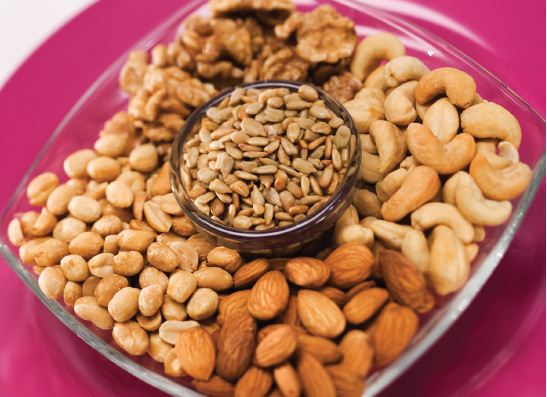For too many Americans, a typical snack consists of unhealthy foods like chips, cookies and candy. If you like to munch on snack foods throughout the day but are also conscious about your health, we suggest a much healthier alternative – nuts. Nuts are full of nutrition, won’t expand your waistline and come in variety of tastes and flavors. Below is a list of some popular nuts and details about their nutritional value:
Almonds
They might seem pretty plain on the outside, but almonds are actually found in exotic locations throughout the Middle East, such asIran,Lebanon,Saudi Arabia,Turkey,SyriaandIsrael. Almonds are also jam-packed with various nutrients; a 1 oz. serving of almonds contains 37% DV of vitamin E. 32% daily value (DV) of manganese, over 20% DV tryptophan, 19% DV magnesium, 17% DV riboflavin, 14% DV copper, and 14% DV phosphorus. They are also a good source of protein, to the tune of 12% daily value, or 5.9 grams.
Together, all these nutrients boost your health in a number of areas. Almonds provide you with plenty of healthy monosaturated fats, which have been shown by several studies to significantly lower your risk of heart disease. When eaten regularly, almonds can lower your levels of bad cholesterol while increasing good cholesterol. Almonds also facilitate the movement of food though your body, which lowers your risk of colon cancer. If all those benefits aren’t enough, almonds can help prevent diabetes and constipation, while simultaneously boosting energy and trimming your waistline.
Peanuts
You can make the argument that peanuts deserve the title of the world’s most popular nut. The acclaim is well deserved, as peanuts are considered a delicious food by snackers all over the world. Ironically, though, peanuts are not technically a nut. They are actually a type of legume, but we’ll still include them on this list regardless, as they are commonly mistaken for a nut.
Peanuts have an impressive résumé: one quarter-cup serving of peanuts contains 26% DV manganese, over 25% DV tryptophan, 19% DV niacin, 8% DV folate and 7% DV copper. Like almonds, peanuts have a good amount of protein, at roughly 7.8g per 1oz serving (or 16% DV). Furthermore, peanuts are also a good source of vitamin E.
Your heart will definitely thank you for eating a proper amount of peanuts; this nut features since vitamin E, niacin, folate, manganese and protein, all of which serve to keep your heart safe from heart disease. Peanuts are also loaded with antioxidants, which take out dangerous free radicals inside the body. Antioxidants have also been shown to promote heart health. Additional research has suggested that regularly consuming peanuts reduces your odds of gaining weight, developing gallstones, and can even lower your risk of Alzheimer’s.
Cashews
These comma-shaped nuts are nutrient goldmines, as a 1 oz. serving has 31% DV copper, 23% DV of manganese, 20% DV of magnesium, 17% DV of phosphorus, 12% DV vitamin K, and 11% DV zinc. Cashews, like the other nuts on this list, are high in monosaturated fat, a type of fat that boosts the performance of your heart if taken in appropriate quantities.
In addition, monosaturated fat is a far healthier alternative to saturated fats, as it reduces your LDL cholesterol count (also known as “bad cholesterol”). Why is this so important? According to the Harvard Medical School Family Health Guide, diets that feature LDL cholesterol-lowering nuts like cashews can significantly cut your risk of heart attack and stroke.
If you aren’t getting enough magnesium in your diet, you might want to grab a handful of cashews; failing to get enough magnesium may increase your odds of developing high blood pressure. Magnesium doesn’t just lower blood pressure – our bones rely on this nutrient to stay firm and strong. Cashews are also a good source of Omega 3 fatty acids, which protect against heart problems such as cardiac arrhythmia.
Pistachios
You’ve probably heard about pistachios before, as pistachio ice cream is fairly popular treat during the hot summer months. Of course, pistachios are much more than the basis for an ice cream flavor. As with other nuts on this list, research has shown that pistachios have the double effect of lowering bad LDL cholesterol while raising good HDL cholesterol. They also provide the body with a good chunk of antioxidants in the form of vitamins A and E. These antioxidants can help prevent a diabetes-related chemical reaction called glycation, which causes damage to body tissue.
Given these health benefits, it’s no surprise that pistachios are rich in nutrients. A 1 oz serving of this nut contains 19% DV copper, 18% DV manganese, 18% DV vitamin B6, 16% DV thiamin and 14% DV phosphorous. The same amount of pistachios will also give your body 12% of the fiber it needs daily.
Walnuts
You can’t do much better than Walnuts for getting copper and manganese; 1 oz of walnuts contains 48% DV of manganese and 22% DV of copper. The same serving size also features 11% DV of magnesium, 10% DV of phosphorus, 9% DV of protein and 8% DV of fiber.
Perhaps most importantly, walnuts contain significant levels of alpha linoleic acids, the plant version of omega 3 fatty acids; just 1/4th a cup of walnuts will give you the entire amount of omega 3 you need for one day. Increasing your omega 3 consumption through walnuts might pay a big dividend; a Spanish study found that diets which emphasized walnuts lead to lower levels of LDL cholesterol in test subjects.
Walnuts can also improve the condition of your heart by preventing irregular heart rhythms, which may indicate an increase risk of blood clots in the heart’s arteries. Walnuts also prevent hardening of the arteries by making them more flexible, and prevent plagues from forming inside these critical passageways.
Pecans
Another type of nut which is high in nutritional value and loaded with taste is pecans. Pecans contain 63% DV of manganese, 17% DV of copper, 12% DV of thiamin, 11% DV of fiber, and 10% DV of magnesium in a 1 oz. serving. These nutrients help to lower bad cholesterol, keep blood pressure at a normal rate, and ensure that the heart’s arteries remain free of blood clots and plague. The fiber in pecans also helps prevent overeating and subsequent weight gain, whereas its phosphorus content promotes bone density.
Hazelnuts
If your diet is lacking in vitamin E, you might consider munching on some hazelnuts; a 1 oz. serving of this nut contains 21% of the recommended daily value of the nutrient. Like its other nutty siblings, hazelnuts are high in both manganese (86% DV) and copper (24% DV), and assists in lowering bad cholesterol and keeping your heart running smoothly. Regularly eating hazelnuts may also reduce your risk of coronary artery disease and stroke. Hazelnuts feature 12% DV of thiamin and 11% DV of fiber.
Brazil Nuts
The name of this nut is a bit misleading, asBrazilnuts are not only harvested inBrazil, but also inPeruandBolivia. These nuts are high in fat, so you shouldn’t eat them more than a few times per week. Despite this drawback, Brazil nuts contain several beneficial nutrients. One of these nutrients is selenium, which has a well-deserved reputation as a power antioxidant. Additionally, a study conducted by theUniversityofIllinoisfound that selenium may help prevent breast cancer. As for other nutrients, Brazil nuts contain 26% DV magnesium, 24% DV copper, 20% DV phosphorus, 17% DV manganese, 8% DV in fiber and 8% protein.
Macadamia Nuts
These nuts are chocked with fiber, protein, healthy monosaturated fat, potassium and magnesium – what’s not to like? Yet another reason to love macadamia nuts is their ability to lower bad cholesterol, which was confirmed in a Universityof Hawaiistudy. Macadamia nuts have 43% DV manganese, 13% thiamin and 9% fiber in a 1 oz. serving.
 Natural Knowledge 24/7 Educate yourself with nutrition, health and fitness knowledge.
Natural Knowledge 24/7 Educate yourself with nutrition, health and fitness knowledge.






